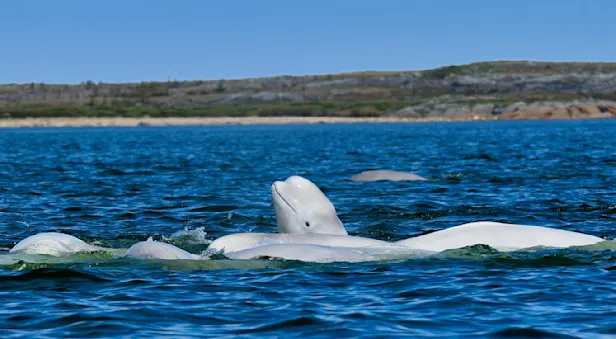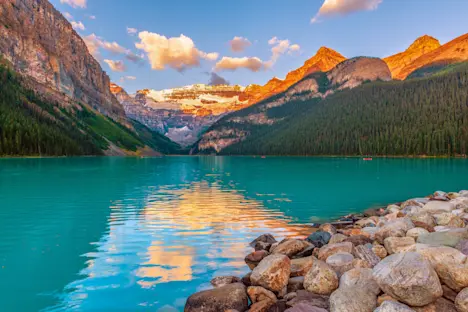
Know Before You Go


Polar Bear Facts | Churchill Summer Wildlife Guide
One of the most remarkable places to view polar bears in the wild is along Hudson Bay’s western shore. Hudson Bay is an expansive body of water, nearly double the size of Texas, spanning 850 miles from north to south and 650 miles east to west. In winter, when the bay freezes, polar bears hunt seals along the leads. In spring, large chunks of ice called “floes” carry the bears towards the southern shore of the bay. The bears emerge on the beach and move inland along the coast.
As summer approaches, the bears start a long journey northward, trekking 800 to 900 miles along the coast to seal-hunting grounds. They walk along the western shore until reaching the northwestern coast once again, where they wait for the ice to freeze. By mid-October, between 600 and 1,000 bears mass along a 100-mile stretch of coast between the Churchill and Nelson rivers. This spectacular gathering is the largest concentration of polar bears on the planet. An abundance of bears, typically males, clusters at headlands, particularly around Cape Churchill. When the ice becomes thick enough to withstand their weight, the bears once again disperse onto the frozen sea to prey upon seals.
Physical Characteristics
The polar bear (Ursus maritimus) is the largest member of the bear family. Females grow until they are about 4 years old and attain a maximum weight of approximately 660 pounds. Males continue to grow until 8 years of age, weighing on average from 1,100 to 1,300 pounds and measuring between eight and 11 feet from nose to tail. The largest recorded polar bear was a male measuring more than 12 feet tall and weighing a reported 2,210 pounds!
The polar bear’s stocky body has a longer neck and proportionately smaller head than other bears. Its powerful musculature is particularly well developed in the hind legs and neck. Its massive forepaws, up to 12 inches in diameter, are larger than the hind paws and are oar-like, with partially webbed toes for more efficient swimming. The soles of the feet are covered with dense pads of fur, offering better traction on ice. The bear’s short tail is inconspicuous, and its ears are small and furry.
A polar bear has excellent eyesight and hearing, and its nose is so incredibly sensitive that it can detect a seal more than 20 miles away! Researchers in Alaska have watched male polar bears march in a straight line, over the tops of pressure ridges of uplifted ice and through open leads, for up to 40 miles, in order to reach a prey animal they had detected. These bears can also sniff out seal dens covered by three feet of ice and snow.
An adult bear’s stomach is very large, with a capacity to hold more than 150 pounds of food. The polar bear’s liver is extremely rich in vitamin A, ranging between 15,000 and 30,000 units per gram, which makes it toxic to humans; there are accounts of Arctic explorers who became ill or even died from vitamin A poisoning after eating it.
Feeding Habits
The polar bear is the king carnivore of the Arctic. Eating almost exclusively meat, it subsists on a diet comprised primarily of sea mammals, particularly ringed seals—the most abundant mammal in the Arctic—which provides the high-fat content polar bears need to thrive. They also prey on bearded seals and occasionally walrus, beluga whale and narwhal. They may supplement their diet with coastline carrion, including crabs, fish and marooned whales, as well as geese, bird eggs and small mammals.
A polar bear’s hunting and eating patterns are completely dependent on sea ice. Sniffing out a seal breathing hole, the bear remains motionless, yards away, or along a lead edge waiting for a seal to surface. When the seal rises, the polar bear bites onto the head or upper body, then flips the entire seal onto the ice. They also stalk ringed seals sleeping on the ice, slowly crawling forward and freezing in place till they are ready to make an explosive pounce from 30-50 feet away, killing the seal before it can slip back into the sea.
During their time on the ice, polar bears survive off their fat reserves for long stretches after gorging on seals. Because of their giant stomachs, polar bears can devour a huge amount of food—up to 150 pounds—at one sitting. This allows them to take full advantage of any temporary windfall. They must, however, eat at least one seal every five to six days to preserve their body weight.
When the summer thaw occurs, polar bears must head to shore where they wander the coastline in search of food. They will consume anything edible, including eggs, reindeer, carrion, and even plants and berries. Even with the addition of this assortment of foods, polar bears lose weight in summer and early autumn as they subsist primarily on stockpiled fat. They are simply too large to receive much energy from small morsels like Arctic hare or fish. And as the seal-hunting season continues to shorten in a warming Arctic, with freeze-up happening later and pack ice melting earlier each year, polar bears may struggle to retain enough fat stores through the long summer seal fast.
Reproduction
A female polar bear typically mates for the first time at 5 or 6 years old. Breeding occurs on the ice pack between late March and mid-July. Males compete fiercely to pursue females in estrus, which generally lasts three weeks. After copulation and fertilization, the embryo will divide a number of times, then halt its development and free-float until it implants into the uterine lining in September.
Pregnant females gain extra layers of fat before entering their winter birthing dens during October or November. They give birth in December or January to one or two blind cubs, weighing a mere 1.25 pounds each. The snow den protects the defenseless newborns from the frigid cold, and they stay inside it until late March or April. Nursing on their mother’s milk, rich in fat, they gain the warm layers of blubber needed to survive harsh Arctic temperatures.
Cubs weigh 22 to 33 pounds when they emerge from their den as daylight hours begin to increase with spring’s arrival. The cubs will have grown to about 25 times their birth weight in two short months. At first, cubs are cautious, playing at the entrance of their den and withdrawing at the slightest hint of danger. After two weeks or so, the cubs become more curious and are large enough to explore the frozen tundra by their mother’s side. She takes them onto the sea ice as she hunts for seals. The mother is extremely thin fasting over the winter, having lived only off her fat stores, so she now gains the energy she needs by hungrily gobbling up the blubber and skin of her kills.
Females have four mammary glands from which the cubs suckle. Nursing occurs for approximately 15 minutes, six to seven times each day. Typically, the mother will hollow out a shallow crater to rest in while she nurses, lying on her back while the cubs nurse on her belly. Occasionally, she will assume an upright position, sitting and leaning forward for the cubs to suckle.
Cubs begin learning to hunt almost at once. Though they continue to rely on their mother’s milk, cubs will eat some of the seal meat caught in their mother’s first hunt after leaving the den. The cubs will follow her everywhere, even clambering on to ride piggyback as she swims. By August, the cubs weigh more than 100 pounds but still rely on their mother, receiving valuable hunting lessons along the way. The cubs and mother usually den together for one or two more winters, although they may remain together as a family for up to four winters.
When the cubs are 24 to 28 months old, the mother leaves them. The young bears, who may stick together at first, eventually wander out on their own across the open tundra. This is a vulnerable time for the cubs, which face their highest risk of death over the next two years. In the Hudson Bay area, due to its abundant food supply, cubs that are weaned after two years have a substantial chance of survival. Males will gain their full weight at 8 to 10 years old, while females will reach their adult size by age 5.
Usually, a female gives birth to a litter every three to four years, but due to the favorable habitat conditions on the Hudson Bay’s western shore, 40 percent of bears in this area produce a litter every two years. By contrast, recent research has revealed that some mothers, facing hardships from harsh conditions in certain Arctic regions, may only give birth to one or two litters during their lifetime.
The Arctic Realm of the Great White Bear
The polar bear can be found wandering the Arctic sea ice in Canada, America, Russia, Norway and Greenland. Until recently, researchers thought the bears would travel in any direction throughout the polar regions of the world, so that a bear last seen near Russia might later appear in Canada, for example. This theory has since been disproven. Although they have a circumpolar distribution, polar bears belong to distinct geographical populations that stay in the same general region year after year. A polar bear’s range is expansive, however, and during the course of a year one may journey over more than 20,000 square miles within a general region.
The North Pole and the Arctic Ocean surrounding the polar ice cap remain frozen year-round. At the edge of the polar basin is sea ice, which breaks apart when the seasons grow warmer. Sea ice is where the polar bear makes its home.
The yearly cycles of freezing and melting ice influence where polar bears and seals are distributed. There are six discrete populations along the polar basin’s southern rim, each influenced by a different pattern of ice movement: the Canadian Arctic, Northern Alaska, Western Alaska and Wrangell Island, Svalbard and Franz Josef Land, Central Siberia, and Greenland. A separate group of bears lives near Hudson Bay in Canada, comprising the planet’s most southerly population.
In the high Arctic, polar bears typically follow the edge of the sea ice as it expands southward during winter. In summer months, as the ice shrinks, the bears return north along the retreating edge. There are exceptions to this pattern, as bears in the Canadian Arctic will often summer on the coast rather than head north with the retreating ice. During summer on Hudson Bay, bears travel inland and cope with the warmth by sheltering in dugouts deep enough to reach permafrost. Though polar bears will typically remain close to shore, they have been spotted nearly 100 miles inland.
Polar bears appear to distribute along the coast according to a hierarchy. Dominant adult males are frequently found in ideal sites near the beach. Females and their cubs are spotted farther inland, with single females and adolescent males living the farthest from the sea.
Travel on These Churchill Adventures
Filter Trips By:

Churchill’s Belugas, Polar Bears & Arctic Wildlife
Meet hundreds of friendly beluga whales up close via Zodiac and kayak, and look for caribou, polar bears, Arctic fox and more on this exhilarating summer adventure in the Canadian subarctic.































